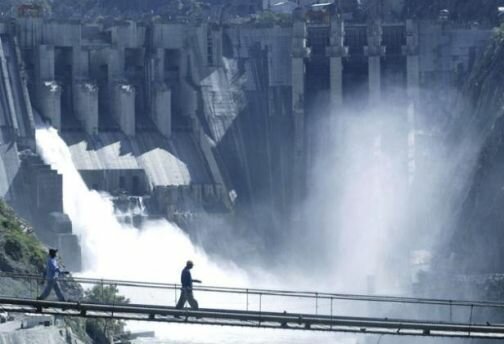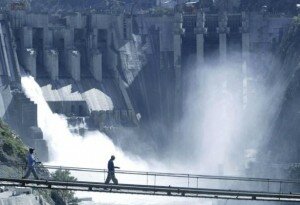
 Print This Post
Print This Post  Email This Post
Email This Post
… And Donates $5 Million To Victims
At least 148 Pakistani villages have been evacuated today because of the Indian action

India's massive Baglihar dam on a river that flows from occupied Kashmir into Pakistan is destabilizing the region. Pakistanis consider it a national security threat. Since 2005, the dam has resulted in reducing Pakistan's share of the water, turning parts of Pakistan's agri plains into arid land. Some Pakistanis suspect the dam played a role in worsening the floods in Pakistani rivers in August 2010.
SPECIAL REPORT
Saturday, 21 August 2010.
ISLAMABAD, Pakistan—While Pakistani foreign minister and his government were busy accepting Indian aid for Pakistani flood victims, New Delhi released a massive 18,000 cusec feet of water from a dam in Indian-occupied Kashmir into Pakistan, prompting fresh fears of floods in the plains of Punjab and Sindh.
On 17 Aug., Pakistani website PakNationalists.com released a report [titled, “Check Indian, Afghan Dams For Floods In Pakistan”] providing indications that minor flooding in northern Pakistan following torrential rains was worsened by India releasing water form tens of small dams that litter occupied Kashmir. These Indian dams have been full for the past two to three years.
An Afghan dam near the Pakistani border, called the Sarobi Dam, is also suspected of releasing vast amounts of water into river Kabul. The Afghan dam is run by an Indian company.
Until a week ago, on 16 Aug., Pakistan’s Meteorological Office confirmed there was no chance of flooding in the northern rivers of Ravi and Satluj.
According to a report in TheNation today, India has released 18,000 cusec of water into Ravi in the early hours of Saturday. It is not clear if the Indians gave Pakistan a 24-hour advance warning in accordance with the water treaty between the two countries. It is also not clear if the release of this amount of water is warranted considering that India has constructed a network of small- and medium-sized dams across Indian-occupied Kashmir adjoining northern Pakistan.
According to the newspaper report, ‘flood warning has been issued here to five drainages of River Ravi catchment areas in wake of possible flood due to release of water in river Ravi by India here on Saturday. As per details, India has release 18000-cusec water in river Ravi that could cause flood in five drainages of Narowal and Shaker Garh. Metrological department had predicted water level in river Ravi would remain low during next 24 hours but after release of water by India low-level flood has hit drainage Bhutsen and Basantar of River Ravi catchment area.
At least 168 villages along river Ravi have been evacuated in wake of possible flood while district administration has been red alerted in Narowal and Sialkot. The flood center in Lahore has given prior high flood warning in drainage located in Shakar Garh. More four drainages Basantar, Jhajri, Oojh and Khattar could be affected by the possible flood. Water inflow of 70,000 cusec at Shahdara could cause massive destruction.
Despite sharing rivers with Afghanistan and Indian-occupied Kashmir, no flooding has been witnessed in either Afghanistan or Indian-occupied Kashmir. Successive waves of flooding in Pakistan despite no rains for the past ten days raise a question mark on the amount of water India has released from its dozens of dams in Kashmir exploiting torrential rains and what initially started as limited flooding in northern Pakistan.
The key point here is that the initial flooding in pockets of northern Pakistan was natural but the subsequent flood waves in the absence of rain are possibly linked to opening the floodgates of Indian dams and the Indian-run Sarobi Dam in Afghanistan. The selective melting of Himalayan glaciers into Pakistan is also a point of consideration. The theory of some experts that the speed of melting at certain glaciers doubled to coincide with torrential rains is highly unlikely and does not explain the successive flood waves in River Kabul coming in from Afghanistan.
There are no Pakistani observers posted at the main Indian dam of Baglihar to check how much water India released into Pakistan during the last two weeks. Baglihar has been a point of contention between Islamabad and New Delhi since 2005. Some analysts in Pakistan have described the dam as a national security threat. The last two years have confirmed Pakistani fears when India blocked Pakistan’s share of the rivers flowing from Kashmir, turning vast agricultural lands of central Pakistani plains into arid zones.
A pro-US Pakistani government is loath to raise this issue with New Delhi in order not to alienate Washington and London, the two capitals that worked for the return from exile of key figures in the incumbent Pakistani government.
On US prodding, the Pakistani government officials have been indirectly defending the Indian position by denying that India is stealing Pakistan’s water and that Pakistan’s problem is water wastage.
2007-2010. All rights reserved. PakNationalists.com
Verbatim copying and distribution of this entire article is permitted in any medium
without royalty provided this notice is preserved.







The author has tried to shoot an arrow in the dark, hoping that it will somehow manage to hit the bulls-eye. I will explain how below:-
1) I am not sure of other rivers but I can talk about Chenab and the Baghlihar dam with a better perspective than the author himself on two counts:- a) I belong to the state of J&K b) I have seen the dam very closely and I have a better knowledge of the same as my father is the Chief Engineer posted on the Baghlihar Dam. The information is not mere googled one but then there are many documented proofs for the same from reputed organisations like Siemens, Lahmeyer etc who have been working on the dam since the very beginning.
2) I agree with author that the dam is a threat to Pakistan and for that matter any dam built on the upstream side always poses a threat to the country on the downstream side. A kindergarten kid knows it. This threat is not by the dam per se but due to many factors like in case there is a breach in the dam or if the water stored in the reservoir is released due to heavy rains and the reservoir can’t hold the water beyond a certain level.
3) Having said all this, first of all the power generation in the Baghlihar happens under a certain water head which is in single digits and the beyond this head water is released. There is no stoppage or blockage of water. This is known as run of the river project and the water from the river is neither blocked nor is utilised in irrigation etc which is in accordance with the Indus Water Treaty. Would the author please explain why the go ahead for the same was given to the project when there are so many reservations.
4) Even if Baghlihar dams hold water on the upstream side, it can’t be released as claimed by Pakistan because on the downstream of this is another dam called Salal Hydel Project in Jyotipuram and the sudden release of water may cause serious damage to this project. I am sure that the author is not aware of this or has simply overlooked.
If it rains in the hills which are the catchment area for rivers the floods happen in the plains, and not in the hills where it rains, due to the slopes the water does not flood the hills but runs off, and there is still very heavy rain going on in the hills, please read about the mud slides in Leh in India brought about by heavy rain (The Indus runs through the Leh area).
Here is a link for the flood in Leh story :-
http://economictimes.indiatimes.com/News/At-least-115-killed-in-Leh-flash-floods-relief-work-on/articleshow/6266621.cms
It seems just propoganda. Why dont we search for the truth? You mean it happenend. Let us cross examine together and find the details. If we find that you lie, you shall have to give proofs and not just another bunch of speculations written sitting on sofa.
[...] -via Ahmed Quraishi [...]
[...] -via Ahmed Quraishi [...]